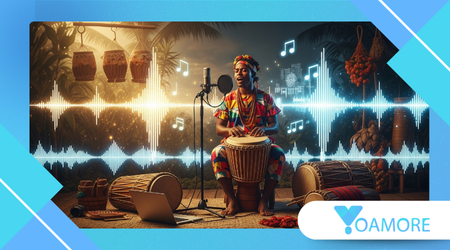The Role of Music in Preserving the Garifuna Language

At the intersection of rhythm and heritage, the role of music in preserving the Garifuna language reveals how melody can guard identity.
Anúncios
This article follows a clear path: first, it explains the Garifuna language’s origins and fragility; next, it examines how music acts as its lifeline; then, it explores contemporary projects, digital revitalization, and community resilience.
Finally, it outlines challenges and a forward-looking vision for this unique Afro-Indigenous culture.
What is the Garifuna Language and Why Does It Matter?
The Garifuna language belongs to the Arawakan family and is spoken by the Garifuna people across coastal regions of Honduras, Belize, Guatemala, and Nicaragua.
Its history embodies survival against colonial disruption. When enslaved Africans and Indigenous Arawak and Carib peoples merged on the island of St. Vincent in the 17th century, they forged a new cultural identity — the Garifuna.
Anúncios
More than just a means of communication, Garifuna carries ancestral memory, maritime knowledge, and spirituality.
According to UNESCO (2023), it is considered a “living heritage” that encodes oral traditions, music, and community rituals essential for intergenerational unity.
Unfortunately, like many minority languages, it faces decline. Global linguistic research by the Endangered Languages Project estimates that nearly 50% of the world’s 7,000 languages may disappear by the end of this century.
The Garifuna language is classified as “vulnerable,” showing urgent need for sustainable preservation.
+ The Secret WW2 Battle Fought with Inflatable Tanks
When Did the Revival Movement Begin?
The modern revitalization of Garifuna identity gained international momentum in the early 2000s, when UNESCO recognized the Language, Music, and Dance of the Garifuna as a Masterpiece of the Oral and Intangible Heritage of Humanity (2001).
This milestone shifted attention from local survival to global awareness.
However, revival had already begun decades earlier. In the 1980s and 1990s, artists such as Andy Palacio from Belize became symbols of cultural restoration.
His award-winning 2007 album Wátina blended traditional rhythms with modern instrumentation and lyrics in Garifuna, revitalizing interest among youth.
Palacio’s global acclaim made music the emotional and linguistic heartbeat of Garifuna identity.
His passing in 2008 was seen as a tragic loss, yet his legacy continues to inspire musicians who link creativity to preservation.
Through this lineage, the role of music in preserving the Garifuna language became deeply intertwined with memory, belonging, and continuity.
+ How Urban Migration Is Silencing Rural Dialects
How Does Music Function as a Language Guardian?
Music’s ability to anchor Garifuna identity lies in its integration with daily life, spirituality, and education. It does not merely accompany the language; it carries it forward.
Every drumbeat, chant, or call-and-response structure acts as linguistic training. Repetition and melody allow speakers — especially children — to internalize grammatical structures naturally.
Unlike textbook learning, musical immersion connects emotion with memory, helping vocabulary stick more effectively.
Traditional songs such as Ayo Da (a funeral chant) or Lidan Aban (a communal song) preserve linguistic expressions that might otherwise vanish.
Lyrics capture idioms, humor, and metaphors that encode collective knowledge. Music thus becomes the oral archive of a people’s worldview.
Moreover, Garifuna musical practice thrives on participation. Drumming circles, spiritual rituals, and dance festivals reinforce both linguistic and cultural unity.
When people sing together, they remember together — transforming language learning into a shared emotional act rather than an academic exercise.
+ Endangered Sign Languages: The Case of Al-Sayyid Bedouin Sign Language
How Has Technology Amplified Preservation Efforts?

In 2025, the intersection of technology and tradition has redefined the role of music in preserving the Garifuna language.
Digital platforms allow this endangered culture to reach global audiences without leaving its authenticity behind.
Garifuna artists are increasingly uploading songs on Spotify, YouTube, and SoundCloud, blending traditional punta and paranda beats with reggae, hip-hop, and Afro-fusion influences.
Younger generations now consume Garifuna music through smartphones, enabling linguistic exposure in spaces once dominated by English or Spanish media.
A 2024 report from the Belize National Institute of Culture and History (NICH) emphasized that online access to Garifuna-language music tripled between 2019 and 2024, showing that digital tools can democratize cultural revival.
This trend not only increases visibility but encourages bilingual creativity.
Which Artists Are Leading This New Wave?
Following Andy Palacio’s influence, contemporary musicians such as Aurelio Martínez from Honduras, Paula Castillo, and James Lovell from Belize have become prominent voices in the new Garifuna music era.
Aurelio, often called “the voice of Garifuna,” fuses Afro-Caribbean rhythms with pure Garifuna lyrics.
His 2021 album Darandi (meaning “legacy”) celebrates elders and linguistic resilience, proving that preservation can coexist with modernity.
Meanwhile, community initiatives like the Lebeha Drumming Center in Hopkins, Belize, teach children how to play drums and sing in Garifuna.
These programs create emotional links between identity and sound, transforming preservation into an act of joy, not obligation.
How Does Music Influence Cultural Pride and Education?
Beyond entertainment, Garifuna music operates as a social educator. It strengthens belonging and raises awareness of cultural roots.
In schools where Garifuna songs accompany lessons, children often show higher engagement and linguistic retention.
A 2023 study published by the University of Belize revealed that incorporating traditional songs into language classes increased vocabulary recall by nearly 40% among primary students.
The rhythm and repetition naturally enhance retention while reinforcing emotional connection to identity.
In diaspora communities, music festivals like Garifuna Settlement Day (November 19) in Belize and Garifuna International Film and Music Festival in Los Angeles also serve as cultural classrooms.
They expose younger Garinagu to music, cuisine, and language — bridging generations through celebration.
Table: Garifuna Music and Linguistic Preservation Initiatives
| Initiative | Location | Description | Impact |
|---|---|---|---|
| Lebeha Drumming Center | Hopkins, Belize | Youth training center teaching Garifuna drumming and songs. | Preserves oral tradition and boosts youth engagement. |
| UNESCO Safeguarding Plan (2006–2009) | Regional | Supported archives, recordings, and training for Garifuna musicians. | Strengthened institutional recognition and language visibility. |
| Garifuna International Festival | Los Angeles, USA | Annual diaspora event combining film, language, and music. | Connects global Garifuna networks and promotes bilingual creativity. |
| Digital Heritage Project | Belize & Honduras | Ongoing 2023–2025 initiative to digitize Garifuna songs and stories. | Provides online access for diaspora learners worldwide. |
When Did Global Recognition Transform Local Efforts?
The turning point came when international platforms began amplifying Garifuna voices.
Global collaborations with artists such as Youssou N’Dour and participation in the World Music Expo (WOMEX) positioned Garifuna music as a global language of resistance.
In 2022, the UN Permanent Forum on Indigenous Issues recognized Garifuna musical heritage as a model for community-led linguistic revitalization.
This acknowledgment validated decades of grassroots activism, showing how cultural resilience can influence international policy.
Such exposure not only protects Garifuna traditions but generates tourism, creative economy, and cross-cultural dialogue — ensuring that preservation remains both sustainable and visible.
Why Does Music Remain More Effective Than Policy Alone?
Legislative measures often struggle to reach the emotional depth that music naturally provides. Policy can institutionalize protection, but music ignites identity.
When Garifuna youth hear songs in their ancestral tongue on streaming platforms or during local ceremonies, they experience language as alive, rhythmic, and relevant.
This emotional engagement turns passive listeners into active speakers.
Moreover, songs adapt more easily than bureaucratic programs. A melody can travel across borders, generations, and social classes — bridging gaps that political initiatives rarely close.
That mobility gives music unmatched endurance as a preservation tool.
What Challenges Still Threaten the Garifuna Language?
Despite progress, obstacles persist. Many young Garifuna migrate to urban areas, where Spanish or English dominate daily life. As older speakers pass away, transmission weakens.
Funding remains inconsistent; community programs often rely on donations or temporary grants.
And while digital exposure helps, it can also dilute authenticity if commercialization overtakes cultural purpose.
In some regions, Garifuna is still absent from public education. Without institutional backing, the language risks surviving only within artistic spaces — powerful but fragile ones.
Sustaining progress demands consistent policy, education reform, and technological innovation.
How Can International Support Strengthen These Efforts?
Partnerships between global institutions and local artists are vital. UNESCO continues to provide visibility, but NGOs and universities must contribute long-term support for archives, scholarships, and music-education initiatives.
Collaborations between the University of Belize, Smithsonian Folkways, and community centers in Dangriga and Livingston have started digital archiving of ancestral songs.
These recordings will feed new learning apps designed to teach Garifuna vocabulary through rhythm, storytelling, and dance.
Such collaborations symbolize a future where preservation and innovation coexist — ensuring that the role of music in preserving the Garifuna language becomes a living dialogue between past and future.
Conclusion
Garifuna heritage is more than history; it’s an ongoing symphony of survival.
The role of music in preserving the Garifuna language demonstrates how rhythm safeguards memory, pride, and identity. Each song echoes centuries of endurance and adaptation.
Music alone cannot replace systemic education or policy reform, yet it remains the most emotionally powerful mechanism of transmission.
By merging technology, creativity, and education, Garifuna people are redefining how endangered languages can thrive in the digital era.
As long as Garifuna drums resonate from Belize to New York, the language will never fall silent.
For further exploration, visit the UNESCO Intangible Heritage Portal (ich.unesco.org) — a global reference for safeguarding linguistic and cultural diversity.
Frequently Asked Questions
Q1: How many fluent Garifuna speakers exist today?
Roughly 100,000 worldwide, according to UNESCO (2023), mostly across Belize, Honduras, and diaspora communities in the United States.
Q2: Which musical genres best represent Garifuna identity?
Punta, paranda, and punta rock form the cultural triad blending traditional drumming with storytelling and spiritual expression.
Q3: Are schools teaching Garifuna language and music?
Yes, though coverage is limited. Pilot programs in Belize and Honduras integrate Garifuna songs into curricula to enhance both language learning and cultural pride.
Q4: How can non-Garifuna individuals support preservation?
Attend cultural events, stream Garifuna artists, and donate to heritage education programs. Responsible cultural tourism also strengthens community economies.
Q5: What’s the future of Garifuna linguistic preservation?
A combination of music, digital archiving, and bilingual education will sustain progress. Technology now serves as both a classroom and a stage for Garifuna voices worldwide.
Through rhythm, memory, and voice, the Garifuna people continue to transform vulnerability into vitality.
The enduring role of music in preserving the Garifuna language remains a global lesson in how culture sings itself into survival.
